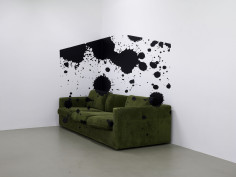IGOR ESKINJA

source: flgallery
Igor Eskinja constructs his architectonics of perception as ensembles of modesty and elegance. The artist “performs” the objects and situations, catching them in their intimate and silent transition from two-dimensional to three-dimensional formal appearance. Using simple, inexpensive materials, such as adhesive tape or electric cables and unraveling them with extreme precision and mathematical exactitude within strict spatial parameters, Eskinja defines another quality that goes beyond physical aspects and enters the registers of the imaginative and the imperceptible. The simplicity of form is an aesthetic quality that opens up a possibility for manipulating a meaning. It derives, as the artist states, from the need for one form to contain various meanings and levels of reading within itself. The tension between multiplicity and void constitutes one of the most important aspects of Eskinja’s mural “drawings” and seemingly flat installations. A void is still an active space of perception; it does not conceal; it comments on the regime of visibility, it invites the viewer to participate in the construction of an imaginary volume in an open space. The temporary nature of the artist’s spatial structures and the ephemeral quality of his carpets (where ornaments are carefully woven out of dust or ash) manifest a resistance to the dominant narratives of institutional apparatus and socio-political order.
.
.
.
.
.
.
.
source: beautifuldecay
Igor Eskinja’s simplistic installations are elegant and optical illusory. Using basic and inexpensive materials such as tape, wires, and cords, Eskinja practices his art with precise measurements and an architectural eye. His work straddles the transition between 2D and 3D perception. He thoughtfully uses the space of the wall and floor of his installations, requiring viewers to stand at a particular angle in order to experience the effect given in these photos. The simplicity of his form and the perception between what is visible and not introduce space for interpretation and meaning. Oftentimes, after the installation is over, the work is thrown out due to the instability of his work, drawing attention to the impermanence of the forms he creates.
.
.
.
.
.
.
.
source: articalillusionaltervistaorg
Igor Eskinja is a Croatian artist; he studied painting at the Accademia di Belle Arti in Venice. Eskinja constructs his architectonics of perception as ensembles of modesty and elegance. The artist “performs” the objects and situations, catching them in their intimate and silent transition from two-dimensional to three-dimensional formal appearance. Using simple, inexpensive materials, such as adhesive tape or electric cables and unraveling them with extreme precision and mathematical exactitude within strict spatial parameters, Eskinja defines another quality that goes beyond physical aspects and enters the registers of the imaginative and the imperceptible. The simplicity of form is an aesthetic quality that opens up a possibility for manipulating a meaning. It derives, as the artist states, from the need for one form to contain various meanings and levels of reading within itself. The tension between multiplicity and void constitutes one of the most important aspects of Eskinja’s mural “drawings” and seemingly flat installations. A void is still an active space of perception; it does not conceal; it comments on the regime of visibility, it invites the viewer to participate in the construction of an imaginary volume in an open space. The temporary nature of the artist’s spatial structures and the ephemeral quality of his carpets (where ornaments are carefully woven out of dust or ash) manifest a resistance to the dominant narratives of institutional apparatus and socio-political order.

